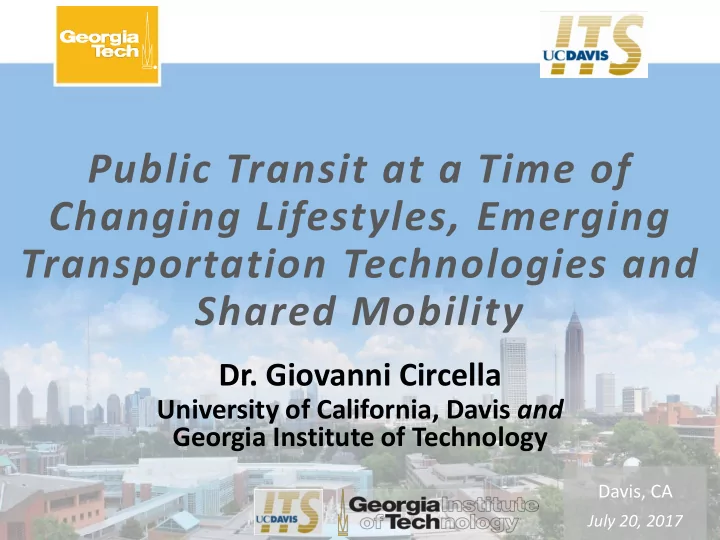

Public Transit at a Time of Changing Lifestyles, Emerging Transportation Technologies and Shared Mobility Dr. Giovanni Circella University of California, Davis and Georgia Institute of Technology Davis, CA July 20, 2017
Impact of Disruptive Technologies Disruptive technologies such as shared mobility , electrification and autonomous vehicles are bringing big changes in: • Transportation supply • Transportation demand Need to update travel demand forecasting to capture effects of new trends … Importance to evaluate impacts on F UTURE the environment and sustainability M OBILITY Role of policy in affecting travelers’ I NITIATIVE response to innovations and the use Policy briefs available at: https://3rev.ucdavis.edu/ (Coming soon…) of travel modes… 2
What is the Impact of Emerging Technologies? • Smartphones (GPS, access to more info) • Increasing opportunities to multitask • Integrated ride-sharing / shared mobility • Impact levels of car-ownership • Extend range of public transportation 3
Car Ownership vs. Shared Mobility 4
What Replaces What? 5
Some Research Questions… • How do customers respond to new mobility choices? • What are the barriers to the adoption of new technological services? • How are other travel options and choices affected? • How does innovation impact mobility for various demographic markets? • How can transit agencies efficiently integrate shared mobility options? 6
Impact of Uber/Lyft Use Impact of last Uber/Lyft trip on 77.4% the use of other means of Reduced the amount of driving I did 70.9% transportation (by age group) Reduced the amount of walking/biking 23.1% 42.0% I did 41.0% Reduced my use of public transportation 48.6% Increased the amount of walking/biking 6.2% I did 4.5% Increased my use of public transportation 11.3% by providing a ride outside public 7.8% transportation hours Increased my use of public transportation 11.3% by providing a better way to access public 9.0% transportation Generation X Millennials 2.1% Other 2.1% 0% 20% 40% 60% 80% 100% N Millennials =333, N Gen X =195 7 Source: Panel Study of Millennials’ Behavior and Emerging Transportation Trends in California (UC Davis)
Impact of Uber/Lyft Use (2) How would you have traveled if Uber/Lyft was not available? 39% Would have driven a car 39% 16% Would have gotten a ride from someone 32% 56% Would have taken taxi 45% 10% Would have walked or biked 24% 11% Would have used public transportation 28% 5% Generation X Would have used a van/shuttle service 7% Millennials 7% Would not have made that trip at all 10% 0% 20% 40% 60% N Millennials =333, N Gen X =195 8 Source: Panel Study of Millennials’ Behavior and Emerging Transportation Trends in California (UC Davis)
Emerging Travel Patterns • Millennials more often adopt shared mobility. • Urban residents that live in zero-vehicle households more likely to use Uber/Lyft more frequently. • Increased land use mix and regional auto accessibility increase the likelihood of using these services. • Tech-savvy individuals with stronger pro-environmental and variety-seeking attitudes more likely to use shared mobility. • Those with stronger preference to have their own car are less likely to use shared mobility services. • Individuals with higher willingness to pay to reduce travel time are high-frequency users. 9 Source: Panel Study of Millennials’ Behavior and Emerging Transportation Trends in California (UC Davis)
Shared Mobility and Travel Behavior How does the adoption of shared mobility affect other components of travel behavior (e.g. use of transit)? Mobility Style Uber/Lyft Public Transit Various modeling approaches: bivariate ordered Probit , recursive Probit , or latent-class structural equation models … 10
Shared Mobility and Travel Behavior How does the adoption of shared mobility affect other components of travel behavior and vehicle ownership ? Jointly model the adoption of shared mobility and use of other modes or vehicle ownership : Data from longitudinal component of panel study (2015-2018) will help disentangle the relationship with vehicle ownership … 11
What Limits the Adoption of Shared Mobility? Concerns about drivers Users Non-users 14.4% 22.5% 36.6% 45.4% 40.3% 40.9% 12 Source: Panel Study of Millennials’ Behavior and Emerging Transportation Trends in California (UC Davis)
What Limits the Adoption of Shared Mobility? Concerns about comfort/safety Users Non-users 14.2% 24.5% 34.7% 49.0% 36.9% 40.8% 13 Source: Panel Study of Millennials’ Behavior and Emerging Transportation Trends in California (UC Davis)
What Limits the Adoption of Shared Mobility? Prefer to have/use my own car Users Non-users 19.6% 28.0% 38.4% 55.6% 24.9% 33.6% 14 Source: Panel Study of Millennials’ Behavior and Emerging Transportation Trends in California (UC Davis)
Availability of the Service Average waiting time to access on-demand ride- hailing services in Northern California 15
Average Waiting Time for UberX minutes SAN LOS SAN SACRAMENTO 15 FRANCISCO ANGELES DIEGO
How can we coordinate use of shared mobility and public transit? • Uber/Lyft can provide first-/last-mile access to transit: – What are the current experiences and pilot projects telling us? • Competition vs. substitution with public transit: – What is the best allocation of funds? Use of curb space, right of way, etc. • Urban form (e.g. low-density regions) not conducive to use transit: – Origins/destinations too far away to make service feasible/profitable (same for shared ride-hailing services)? – How do innovations influence mobility in urban, suburban and/or rural areas? • How will the transportation landscape change with AVs? – Blending of public/private transportation? Opportunities for microtransit? Important role of policies to align with societal benefits … and space for research partnerships to generate knowledge in this area… F UTURE M OBILITY I NITIATIVE 17
For more information, please contact: Dr. Giovanni CIRCELLA Institute of Transportation Studies, University of California, Davis gcircella@ucdavis.edu
Recommend
More recommend